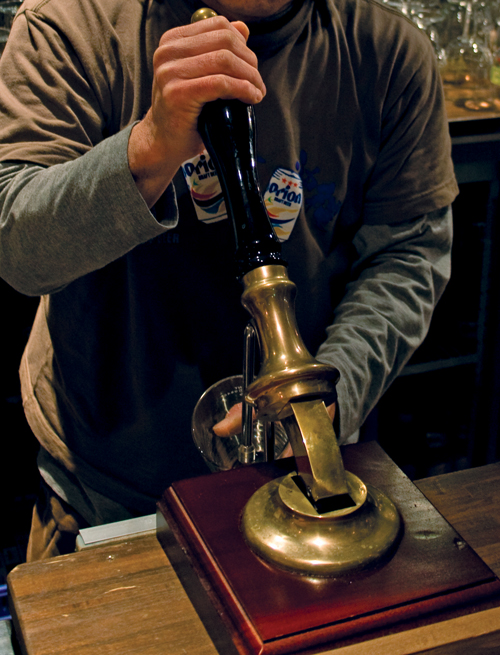
Definitions may vary depending on whom you ask, but most generally, real ale refers to a type of beer whose secondary fermenting activity takes place in its serving container. This could include bottle-conditioned ales, but many people (certainly purists) stipulate that real ale be cask-conditioned. The beer is “real” or “alive” because the yeast is still active and conditioning the beer. Furthermore, real ale is served without any external carbon dioxide or nitrogen, which is why you see hand-pumps for it at the bar. Since malt produces carbon dioxide during fermentation, there will be some naturally occurring amounts. However, brewers will often let much of this escape before serving. Finally, under the strictest definitions, real ale should use “traditional ingredients,” meaning no artificial preservatives or additives.
This later restriction reflects the origins of real ale. The term itself owes its existence to four British men who were vacationing in western England in 1971. They began lamenting the deteriorating quality of beer—a result, they believed, of large commercial brewing methods. They consequently launched the “Campaign for the Revitalisation of Ale,” renaming it the Campaign for Real Ale (CAMRA) in 1973. As they were fiercely opposed to the homogenization of British brewing, their campaign worked to promote small brewers and related pubs. With growing membership, the group also worked to reform licensing and beer tax laws. Today, CAMRA is the largest single-issue (“real ale”) consumer group in England, boasting over 100,000 members and 200 local branches. The political power of those numbers is respectable. They are plenty high enough to ensure that small breweries thrive in greater numbers and that craft beer drinkers can enjoy a wider range of tastes.
That real ale taste—and the unique aroma— derives, once again, from the beer being “alive.” But that also makes real ale fickle. When kept at a proper temperature, it matures and the flavor comes out. When stored improperly or kept too long, it goes bad. It is therefore truly a craft beer and requires great attention and care. That, and appreciative drinkers. They shouldn’t be hard to find.
Japan has its own real ale movement! The Real Ale Festival will hold its 8th event February 14th. www.tokyorealale.org
This article was published in Japan Beer Times # () and is among the limited content available online. Order your copy through our online shop or download the digital version from the iTunes store to access the full contents of this issue.



